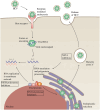Understanding the relationship between HCV infection and progression of kidney disease
- PMID: 39006752
- PMCID: PMC11239345
- DOI: 10.3389/fmicb.2024.1418301
Understanding the relationship between HCV infection and progression of kidney disease
Abstract
Hepatitis C virus (HCV) can cause a range of kidney diseases. HCV is the primary cause of mixed cryoglobulinaemia, which leads to cryoglobulinaemic vasculitis and cryoglobulinaemic glomerulonephritis (GN). Patients with acute cryoglobulinaemic vasculitis often exhibit acute kidney disease due to HCV infection, which typically progresses to acute kidney injury (AKI). HCV also increases the risk of chronic kidney disease (CKD) and the likelihood of developing end-stage renal disease (ESRD). Currently, direct-acting antiviral agents (DAAs) can be used to treat kidney disease at different stages. This review focuses on key findings regarding HCV and kidney disease, discusses the impact of DAAs, and highlights the need for further research and treatment.
Keywords: acute kidney injury; cryoglobulinaemia; diabetic nephropathy; glomerulonephritis; hepatitis C virus; lupus nephritis; renal cell carcinoma.
Copyright © 2024 Zhang, Han, Lin, Jin, Zhou, Wang, Tang, Li, Li and Chen.
Conflict of interest statement
The authors declare that the research was conducted in the absence of any commercial or financial relationships that could be construed as a potential conflict of interest.
Figures



Similar articles
-
Hepatitis C virus infection and acute or chronic glomerulonephritis: an epidemiological and clinical appraisal.Nephrol Dial Transplant. 1998 Aug;13(8):1991-7. doi: 10.1093/ndt/13.8.1991. Nephrol Dial Transplant. 1998. PMID: 9719153
-
Hepatitis C virus associated glomerulopathies.World J Gastroenterol. 2014 Jun 28;20(24):7544-54. doi: 10.3748/wjg.v20.i24.7544. World J Gastroenterol. 2014. PMID: 24976695 Free PMC article. Review.
-
Acute interstitial nephritis following treatment with direct-acting antiviral agents in hepatitis C virus-infected patients: A case series.Clin Nephrol. 2021 Jan;95(1):22-27. doi: 10.5414/CN110276. Clin Nephrol. 2021. PMID: 32909545
-
[Instructions and implementations for percutaneous renal biopsy. Guidelines for the therapy of glomerular nephropaties].G Ital Nefrol. 2003 Sep-Oct;20 Suppl 24:S3-47. G Ital Nefrol. 2003. PMID: 14666502 Review. Italian.
-
Hepatitis C and kidney disease: A narrative review.J Adv Res. 2017 Mar;8(2):113-130. doi: 10.1016/j.jare.2016.07.004. Epub 2016 Jul 26. J Adv Res. 2017. PMID: 28149647 Free PMC article. Review.
Cited by
-
The Role of Viral Infections in Acute Kidney Injury and Mesenchymal Stem Cell-Based Therapy.Stem Cell Rev Rep. 2025 Jun;21(5):1199-1236. doi: 10.1007/s12015-025-10873-0. Epub 2025 Apr 8. Stem Cell Rev Rep. 2025. PMID: 40198477 Review.
References
Publication types
LinkOut - more resources
Full Text Sources

